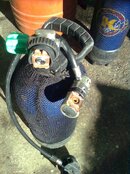- Messages
- 369
- Reaction score
- 60
Recently someone I know had a regulator explode while hooked up to a cylinder. Luckily nobody got hurt, but only be sheer luck since the regulator got ejected like a projectile. The diver never named the manufacturer of the reg, but it does look like a ScubaPro based on the photo. A friend of mine did some research and found a few pointers that may be related:
Warning! Scubapro MK 10 fault [Archive] - ScubaBoard
Scubapro MK20 Cracking Problem Deepens: Undercurrent 08/2005
It looks like there have been a few incidents when various ScubaPro regs have cracked in a very similar way. The problem seems to be traceable to cracking of the regulator body at the base of the DIN/Yoke female threads as result of too much tension on the threads from the DIN adapter / Yoke nut. It looks like a very real and legitimate point of concern.
From experience, I know that the DIN adapter needs to be quite snug, otherwise it easily comes loose when the regulator is attached to a cylinder. I tend to tighten it as much as possible with a torque wrench, but I don't seem to get anywhere close to the manufacturer specs. Which is quite surprising to me since I already feel like I have tightened the piece a lot and have always been worried about the effect on the threads.
So, does anyone know anything about this problem with ScubaPro (or other brands)? Do you know if ScubaPro have addressed it and how (particularly for DIN adapters)? Is there a reason to be concerned? How much do you tighten your "DIN adapter" to the regulator body so that it doesn't come loose yet it's not overtightened?
Warning! Scubapro MK 10 fault [Archive] - ScubaBoard
Scubapro MK20 Cracking Problem Deepens: Undercurrent 08/2005
It looks like there have been a few incidents when various ScubaPro regs have cracked in a very similar way. The problem seems to be traceable to cracking of the regulator body at the base of the DIN/Yoke female threads as result of too much tension on the threads from the DIN adapter / Yoke nut. It looks like a very real and legitimate point of concern.
From experience, I know that the DIN adapter needs to be quite snug, otherwise it easily comes loose when the regulator is attached to a cylinder. I tend to tighten it as much as possible with a torque wrench, but I don't seem to get anywhere close to the manufacturer specs. Which is quite surprising to me since I already feel like I have tightened the piece a lot and have always been worried about the effect on the threads.
So, does anyone know anything about this problem with ScubaPro (or other brands)? Do you know if ScubaPro have addressed it and how (particularly for DIN adapters)? Is there a reason to be concerned? How much do you tighten your "DIN adapter" to the regulator body so that it doesn't come loose yet it's not overtightened?






